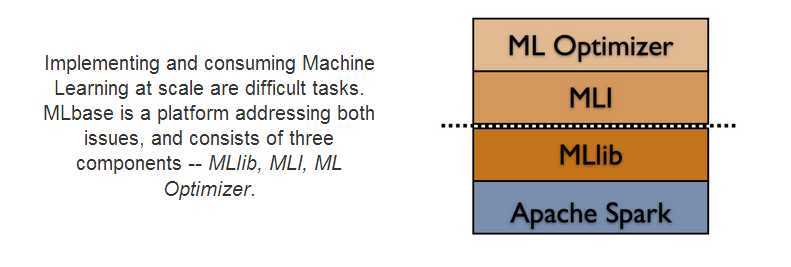标签:des style blog http color io os ar 使用
1.什么是MLBase
MLBase是Spark生态圈的一部分,专注于机器学习,包含三个组件:MLlib、MLI、ML Optimizer。
2.MLbase机器学习算法的流程
用户可以容易地使用MLbase这个工具来处理自己的数据。大部分的机器学习算法都包含训练以及预测两个部分,训练出模型,然后对未知样本进行预测。Spark中的机器学习包也是如此。
Spark将机器学习算法都分成了两个模块:
MLbase提供了函数式编程语言Scala,利用MLlib可以很方便的实现机器学习的常用算法。
比如说,我们要做分类,只需要写如下scala代码:
1 var X = load("some_data", 2 to 10) 2 var y = load("some_data", 1) 3 var (fn-model, summary) = doClassify(X, y)
代码解释:X是需要分类的数据集,y是从这个数据集里取的一个分类标签,doClassify()分类。
这样的处理有两个主要好处:
MLbase的三大组成部分之一:ML Optimizer,会选择它认为最适合的已经在内部实现好了的机器学习算法和相关参数,来处理用户输入的数据,并返回模型或别的帮助分析的结果。总体上的处理流程如下图:

MLbase不仅仅把结果返回给用户。在LLP、Optimizer,MLbase会存储一些中间结果和特征,然后会继续搜寻和测试结果更好的算法和相关参数,并且会通知用户。LLP内部实现的算法是可以扩充的。
总之,MLbase会自动寻找合适的算法,自动选择和优化,还可以进行扩充。
3.Scala实现KMeans算法
3.1 什么是KMeans算法
K-Means算法是一种cluster analysis的算法,其主要是来计算数据聚集的算法,主要通过不断地取离种子点最近均值的算法。
具体来说,通过输入聚类个数k,以及包含 n个数据对象的数据库,输出满足方差最小标准的k个聚类。
3.2 k-means 算法基本步骤
(1) 从 n个数据对象任意选择 k 个对象作为初始聚类中心;
(2) 根据每个聚类对象的均值(中心对象),计算每个对象与这些中心对象的距离;并根据最小距离重新对相应对象进行划分;
(3) 重新计算每个(有变化)聚类的均值(中心对象);
(4) 计算标准测度函数,当满足一定条件,如函数收敛时,则算法终止;如果条件不满足则回到步骤(2)。
算法的时间复杂度上界为O(n*k*t), 其中t是迭代次数,n个数据对象划分为 k个聚类。
3.3 MLlib实现KMeans
以MLlib实现KMeans算法,利用MLlib KMeans训练出来的模型,可以对新的数据作出分类预测,具体见代码和输出结果。
Scala代码:

1 package com.hq 2 3 import org.apache.spark.mllib.clustering.KMeans 4 import org.apache.spark.mllib.linalg.Vectors 5 import org.apache.spark.{SparkContext, SparkConf} 6 7 object KMeansTest { 8 def main(args: Array[String]) { 9 if (args.length < 1) { 10 System.err.println("Usage: <file>") 11 System.exit(1) 12 } 13 14 val conf = new SparkConf() 15 val sc = new SparkContext(conf) 16 val data = sc.textFile(args(0)) 17 val parsedData = data.map(s => Vectors.dense(s.split(‘ ‘).map(_.toDouble))) 18 val numClusters = 2 19 val numIterations = 20 20 val clusters = KMeans.train(parsedData,numClusters,numIterations) 21 22 println("------Predict the existing line in the analyzed data file: "+args(0)) 23 println("Vector 1.0 2.1 3.8 belongs to clustering "+ clusters.predict(Vectors.dense("1.0 2.1 3.8".split(‘ ‘).map(_.toDouble)))) 24 println("Vector 5.6 7.6 8.9 belongs to clustering "+ clusters.predict(Vectors.dense("5.6 7.6 8.9".split(‘ ‘).map(_.toDouble)))) 25 println("Vector 3.2 3.3 6.6 belongs to clustering "+ clusters.predict(Vectors.dense("3.2 3.3 6.6".split(‘ ‘).map(_.toDouble)))) 26 println("Vector 8.1 9.2 9.3 belongs to clustering "+ clusters.predict(Vectors.dense("8.1 9.2 9.3".split(‘ ‘).map(_.toDouble)))) 27 println("Vector 6.2 6.5 7.3 belongs to clustering "+ clusters.predict(Vectors.dense("6.2 6.5 7.3".split(‘ ‘).map(_.toDouble)))) 28 29 println("-------Predict the non-existent line in the analyzed data file: ----------------") 30 println("Vector 1.1 2.2 3.9 belongs to clustering "+ clusters.predict(Vectors.dense("1.1 2.2 3.9".split(‘ ‘).map(_.toDouble)))) 31 println("Vector 5.5 7.5 8.8 belongs to clustering "+ clusters.predict(Vectors.dense("5.5 7.5 8.8".split(‘ ‘).map(_.toDouble)))) 32 33 println("-------Evaluate clustering by computing Within Set Sum of Squared Errors:-----") 34 val wssse = clusters.computeCost(parsedData) 35 println("Within Set Sum of Squared Errors = "+ wssse) 36 sc.stop() 37 } 38 }
3.4 以Spark集群standalone方式运行
①在IDEA打成jar包(如果忘记了,参见Spark:用Scala和Java实现WordCount),上传到用户目录下/home/ebupt/test/kmeans.jar
②准备训练样本数据:hdfs://eb170:8020/user/ebupt/kmeansData,内容如下
[ebupt@eb170 ~]$ hadoop fs -cat ./kmeansData
1.0 2.1 3.8
5.6 7.6 8.9
3.2 3.3 6.6
8.1 9.2 9.3
6.2 6.5 7.3
③spark-submit提交运行
[ebupt@eb174 test]$ spark-submit --master spark://eb174:7077 --name KmeansWithMLib --class com.hq.KMeansTest --executor-memory 2G --total-executor-cores 4 ~/test/kmeans.jar hdfs://eb170:8020/user/ebupt/kmeansData
输出结果摘要:
1 ------Predict the existing line in the analyzed data file: hdfs://eb170:8020/user/ebupt/kmeansData 2 Vector 1.0 2.1 3.8 belongs to clustering 0 3 Vector 5.6 7.6 8.9 belongs to clustering 1 4 Vector 3.2 3.3 6.6 belongs to clustering 0 5 Vector 8.1 9.2 9.3 belongs to clustering 1 6 Vector 6.2 6.5 7.3 belongs to clustering 1 7 -------Predict the non-existent line in the analyzed data file: ---------------- 8 Vector 1.1 2.2 3.9 belongs to clustering 0 9 Vector 5.5 7.5 8.8 belongs to clustering 1 10 -------Evaluate clustering by computing Within Set Sum of Squared Errors:----- 11 Within Set Sum of Squared Errors = 16.393333333333388
4.MLbase总结
本文主要介绍了MLbase如何实现机器学习算法,简单介绍了MLBase的设计思想。总的来说,Mlbase的核心是ML Optimizer,把声明式的任务转化成复杂的学习计划,输出最优的模型和计算结果。
与其它机器学习系统Weka、mahout不同:
5.参考文献
Spark MLBase分布式机器学习系统入门:以MLlib实现Kmeans聚类算法
标签:des style blog http color io os ar 使用
原文地址:http://www.cnblogs.com/byrhuangqiang/p/4035173.html